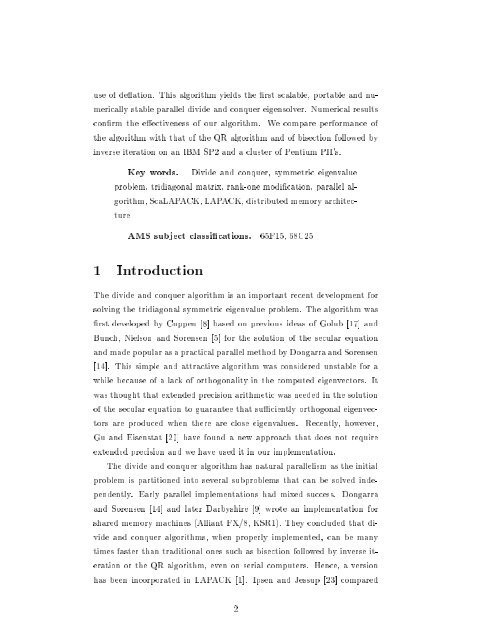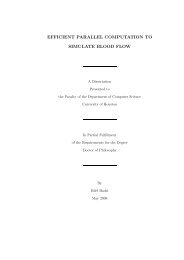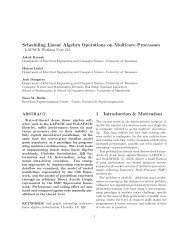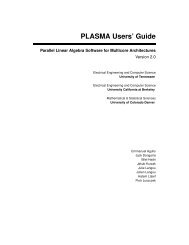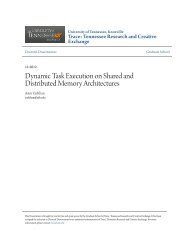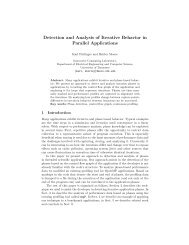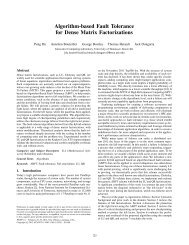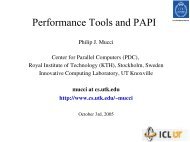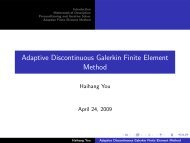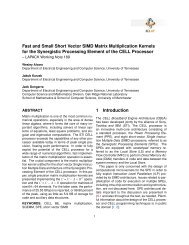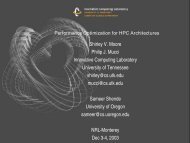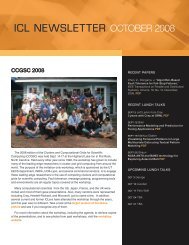Parallelizing the Divide and Conquer Algorithm - Innovative ...
Parallelizing the Divide and Conquer Algorithm - Innovative ...
Parallelizing the Divide and Conquer Algorithm - Innovative ...
Create successful ePaper yourself
Turn your PDF publications into a flip-book with our unique Google optimized e-Paper software.
use of deation. This algorithm yields <strong>the</strong> rst scalable, portable <strong>and</strong> numerically<br />
stable parallel divide <strong>and</strong> conquer eigensolver. Numerical results<br />
conrm <strong>the</strong> eectiveness of our algorithm. We compare performance of<br />
<strong>the</strong> algorithm with that of <strong>the</strong> QR algorithm <strong>and</strong> of bisection followed by<br />
inverse iteration on an IBM SP2 <strong>and</strong> a cluster of Pentium PII's.<br />
Key words. <strong>Divide</strong> <strong>and</strong> conquer, symmetric eigenvalue<br />
problem, tridiagonal matrix, rank-one modication, parallel algorithm,<br />
ScaLAPACK, LAPACK, distributed memory architecture<br />
AMS subject classications.<br />
65F15, 68C25<br />
1 Introduction<br />
The divide <strong>and</strong> conquer algorithm is an important recent development for<br />
solving <strong>the</strong> tridiagonal symmetric eigenvalue problem. The algorithm was<br />
rst developed by Cuppen [8] based on previous ideas of Golub [17] <strong>and</strong><br />
Bunch, Nielson <strong>and</strong> Sorensen [5] for <strong>the</strong> solution of <strong>the</strong> secular equation<br />
<strong>and</strong> made popular as a practical parallel method by Dongarra <strong>and</strong> Sorensen<br />
[14]. This simple <strong>and</strong> attractive algorithm was considered unstable for a<br />
while because of a lack of orthogonality in <strong>the</strong> computed eigenvectors. It<br />
was thought that extended precision arithmetic was needed in <strong>the</strong> solution<br />
of <strong>the</strong> secular equation to guarantee that suciently orthogonal eigenvectors<br />
are produced when <strong>the</strong>re are close eigenvalues. Recently, however,<br />
Gu <strong>and</strong> Eisenstat [20] have found a new approach that does not require<br />
extended precision <strong>and</strong> we have used it in our implementation.<br />
The divide <strong>and</strong> conquer algorithm has natural parallelism as <strong>the</strong> initial<br />
problem is partitioned into several subproblems that can be solved independently.<br />
Early parallel implementations had mixed success. Dongarra<br />
<strong>and</strong> Sorensen [14] <strong>and</strong> later Darbyshire [9] wrote an implementation for<br />
shared memory machines (Alliant FX/8, KSR1). They concluded that divide<br />
<strong>and</strong> conquer algorithms, when properly implemented, can be many<br />
times faster than traditional ones such as bisection followed by inverse iteration<br />
or <strong>the</strong> QR algorithm, even on serial computers. Hence, a version<br />
has been incorporated in LAPACK [1]. Ipsen <strong>and</strong> Jessup [23] compared<br />
2


